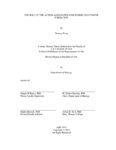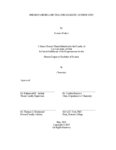TO
Filters: Format: "application/pdf" School Or College: "College of Science" Collection: "ir_htoa" Year Graduated: "2015"
1 - 25 of 17
| Creator | Title | Description | Subject | Date | ||
|---|---|---|---|---|---|---|
| 1 |
 |
Lee, Charles Chang Suk | A demonstration apparatus for optical pumping of rubidium | Optical pumping refers to the use of light in order to elevate ("pump") the spin (intrinsic angular momentum) of an atom or molecule. This process is of interest from a pedagogical and experimental perspective because it encapsulates fundamental properties of atomic physics and quantum mechanics. Fu... | Optical pumping -- Research Spin exchange -- Research Rubidium isotopes -- Research | 2015-05 |
| 2 |
 |
Arave, Rowan A. | AKT1 activation promotes the development of melanoma metastasis | Metastases are the major cause of melanoma-related mortality. Previous studies implicating aberrant AKT (or protein kinase B) signaling in human melanoma metastases led to the evaluation of the effect of activated AKT1 expression in non-metastatic BRAFV600E/cyclin dependent kinase inhibitor 2a nu... | Melanoma; genetics; research; metastasis; genetics; research; biochemistry; genetics | 2015-12 |
| 3 |
 |
Zhu, Judy | Analysis of the pH-dependent equilibrium relationship between the guanine oxidation products 5-guanidinohydantoin and iminoallantoin | Oxidation of 2'-deoxyguanosine (dG) results in the major two-electron product 8-oxo-7,8-dihydro-2'-deoxyguanosine (dOG) that can undergo further oxidation to other products. One such product is 5-guanidinohydantoin (dGh) that is highly mutagenic and has been found in vivo. The ring architecture of d... | Oxidation; guanine oxidation products; 5-guanidinohydantoin; iminoallantoin; equilibrium relationship | 2015-05 |
| 4 |
 |
Ellingson, Drew | Bitangent lines to planar quartic curves in algebraic and tropical geometry | Bitangents are lines which are tangent to a curve at two points. The bitangents of a classical quartic are well understood, and a result originally due to Cayley tells us that there are always precisely 28 bitangents to a generic quartic plane curve. When looking at Tropical Geometry, the situation ... | Tropical geometry; Curves, Quartic; Curves, Algebraic; Bitangents | 2015-04 |
| 5 |
 |
Evans, Kathryn S. | Defining the interaction between ETV4 and mediator subunit MED25 | Chromosomal rearrangements resulting in an overexpression of a subset of ETS transcription factors (ETV1, ETV4, ETV5, and ERG) are found in over 50% of prostate cancers (Tomlins et al., 2005). ERG and ETV1 have both shared and distinct gene targets, yet overexpression of ETV1 is often found to be as... | Transcription factors; Prostate -- Cancer -- Genetic aspects; ETV4 | 2015-05 |
| 6 |
 |
Chen, Jason J. | Dissecting the genetic and learned components of oscine birdsong | The interplay of genetically encoded and learned components in the development of the learned vocal signals of birdsong and human speech in not fully understood (Forstmeier et al, 2009). The fact that song is a learned vocal behavior does not imply the lack of a genetic basis in acquiring vocalizati... | Birdsongs -- Research; Songbirds -- Genetics -- Research; Zebra finch -- Research; Nature and nurture -- Research; birdsong; Taeniopygia guttata | 2015-12 |
| 7 |
 |
Fernandez, Florence | Evaluation of environmental education in high school science courses across Salt Lake City, Utah | While the effects of pollution become Incredibly more evident in the air of the Salt Lake Valley, many Utah high school students still lack the knowledge and information necessary to take preventative and immediate actions to protect their health and their environment. In this study, the reasons for... | Environmental education -- Utah -- Salt Lake City; Science -- Study and teaching -- Utah -- Salt Lake City; Air -- Pollution -- Utah -- Salt Lake City | 2015-05 |
| 8 |
 |
Kutschke, Michael | Hip joint center differences between dual fluoroscopy, functional hip, and coda - establishing a reference standard | Measurements of joint angles, moments, and forces may be highly sensitive to positional changes in the center of a joint. Due to its deep location, the human hip joint center (HJC) can be difficult to determine. Previous studies have defined the HJC relative to external landmarks using infrared moti... | Hip joint; Hip joint center | 2015-05 |
| 9 |
 |
Black, Alyssa | Identifying hybrid male sterility genes in Drosophila Pseudoobscura | Speciation, the process of one species splitting into two separate species, often involves the evolution of hybrid sterility or hybrid inviability. These reproductive isolating barriers are caused by negative interactions between genes called hybrid incompatibilities. Identifying hybrid incompatibil... | Infertility, Male -- Genetic aspects Drosophila pseudoobscura -- Genetics Male sterility genes | 2015-05 |
| 10 |
 |
Beams, Alexander | Implications of antibiotic use for co-infections when a fitness trade-off for resistance is present | How much does indiscriminate antibiotic use promote the spread of antibiotic-resistant infections in a population? Assuming a fitness trade-off for resistance exists, it is possible for an antibiotic-vulnerable strain to outlast a resistant type within an untreated host carrying both. That means pru... | Drug resistance in microorganisms -- Mathematical models Co-infections | 2015 |
| 11 |
 |
Allam, Jeremy | Low-energy satellite transfer from Earth to Mars | A new type of satellite transfer that uses half the amount of fuel as conventional transfers has been discovered. This transfer, called a low-energy transfer, proved to work in 1991 when a Japanese satellite successfully went in orbit around the moon using this technique. Since then, more research h... | Space vehicles -- Dynamics -- Mathematics Space flight to Mars -- Mathematics | 2015-04 |
| 12 |
 |
Shimko, Tyler | Mapping suppressors of premature sperm activation in C. Elegans | The sperm of the roundworm Caenorhabditis elegans move by a crawling motion, in contrast to mammalian sperm, which exhibit a swimming motion. This method of locomotion makes the sperm of C. elegans an excellent model for examining cell motility. In order to become motile, the sperm must undergo the ... | Caenorhabditis elegans -- Spermatozoa; Sperm activation | 2015-05 |
| 13 |
 |
Tuft, Marie | Quantitative analysis of virus trafficking in a biological cell | Virus replication is a complex process that is important to understand. If a virus is to successfully infect a host cell it must travel from the cell wall to the nucleus by hijacking that cell's existing transport system of microtubules. This motion occurs as two iterated steps: passive diffusion th... | Viruses -- Reproduction -- Mathematical models; Virus trafficking | 2015-05 |
| 14 |
 |
Wang, Zhirong | The role of the autism-associated gene kirrel3 in synapse formation | Alterations in the gene Kirrel3 are repeatedly associated with intellectual disability and autism. Kirrel3 regulates synapse formation in C. elegans but the role of Kirrel3 in synapse formation in the mammalian brain is unknown. In mice, Kirrel3 is expressed in specific cell types throughout the bra... | Autism -- Genetic aspects; Synapses; Kirrel3 gene; Synapse formation | 2015-04 |
| 15 |
 |
Jensen, Trey W. | Spectral evolution in high redshift quasars from the final boss sample | We report on a study of the spectral variations in a sample of 102,150 quasars from the Baryon Oscillation Spectroscopic Survey (BOSS) of the Sloan Digital Sky Survey (SDSS-III). After mitigating selection effects and Malmquist bias over the redshift range 2:1 □ z □ 3:5, we create high... | Quasars -- Spectra; Red shift -- Observations; Baryon Oscillation Spectroscopic Survey; Sloan Digital Sky Survey; Redshift evolution | |
| 16 |
 |
Skedros, Gregory Athanasios | Structural and material changes in the sheep radius from newborn to adult: Functional adaptation versus developmental constraint | Bones that exhibit marked changes in structural and material characteristics during ontogeny are potentially useful for studying the mechanisms that produce functional adaptations. The diaphyseal region of the sheep radius was examined because it is relatively simply loaded in cranial-caudal bending... | Functional adaptations - Sheep; Developmental constraint - Sheep; Ontogeny | 2015-08 |
| 17 |
 |
Walker, Kortnie | Understanding and treating diabetic retinopathy | Diabetic retinopathy is a neurovascular disease of the retina and is the leading cause of blindness in the working-age population in the United States. Complications as a result of hyperglycemia and diabetes mellitus (DM) break down the blood-retina barrier (BRB) and retinal vasculature. Current tre... | Diabetic retinopathy | 2015-05 |
1 - 25 of 17
